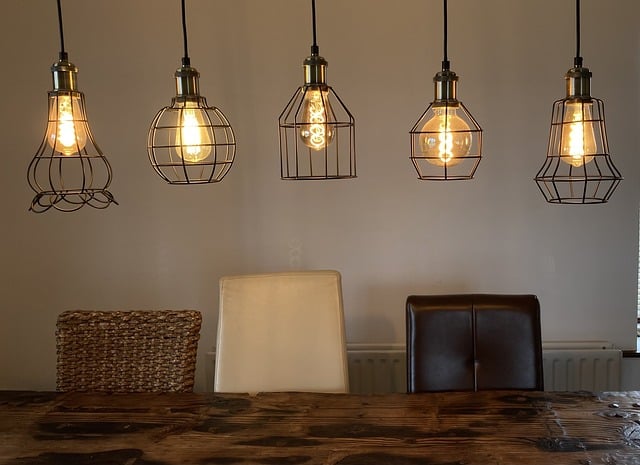Fluorescent
A gas discharge and phosphor coating are used in fluorescent lighting technology to produce light. An electric current is run through a tube that contains low-pressure mercury vapor and an inert gas, such as argon or krypton, in fluorescent light. The mercury atoms are excited by the electric current, which causes them to produce ultraviolet (UV) light.
The phosphor coating placed on the inside of the tube then responds to the UV light. The phosphors absorb UV radiation, which then reemits it as visible light. Different phosphor coatings can produce light colors ranging from warm to cool or daytime tones.
Compared to conventional incandescent lights, fluorescent lights are renowned for their energy efficiency. They generate less heat while converting a more significant part of the electrical energy into visible light. Fluorescent lighting is frequently utilized in various locations, such as homes, businesses, and factories, as well as in uses, including office lighting, retail spaces, hospitals, and schools.
It's important to remember that there are various kinds of fluorescent lighting, including fluorescent tubes and compact fluorescent lamps (CFLs), each having a unique design and use.
Incandescent
A form of lighting technology known as an incandescent produces light by running an electric current through a filament, which heats up and releases visible light. Tungsten, a metal with a high melting point, is often used as the filament in incandescent light bulbs.
The filament glows and emits light when an electric current is applied, making it heat up to a high temperature. Incandescent lights appear warm and yellowish because of the broad spectrum of colors they emit. A traditional, homely lighting ambiance is frequently linked with incandescent lights.
In many different uses, including household illumination, ornamental lighting, and specific vehicle lighting, incandescent lights have been utilized for many years. They are renowned for having low energy efficiency, nevertheless. Incandescent bulbs use a lot of electricity, but the bulk of that energy is turned into heat rather than visible light. Compared to more recent lighting technologies like fluorescent and LED lights, incandescent lights are less energy-efficient.
In many countries, incandescent lights have been phased out or banned due to their lower energy efficiency and adverse environmental effects, and more energy-efficient lighting options like compact fluorescent lamps (CFLs) and LED lights have grown in popularity.
LED (Light Emitting Diode)
Light-emitting diode, or LED. It is a type of lighting in which an electric current is passed through a semiconductor material to cause it to emit light. Due to its many advantages over conventional lighting technologies like incandescent and fluorescent lights, LEDs have grown in popularity over the past few years.
LEDs operate via a mechanism known as electroluminescence, in contrast to incandescent lights, which rely on heating a filament, and fluorescent lights, which use gas discharge and phosphor coating.
An LED produces visible light when an electric current is provided to the semiconductor material inside the device. It is accomplished by moving electrons within the semiconductor material, which releases energy in photons.
Energy Savings: LEDs have excellent energy savings. They minimize energy waste and lower electricity costs by turning a considerable part of the energy they use directly into light. LEDs have a potential efficiency advantage of up to 80% over incandescent lights.
Long Lifespan: LEDs have an incredibly long lifespan compared to other lighting alternatives. They outlast incandescent and fluorescent lights by a large margin, lasting up to 50,000 hours or more. This longevity decreases the cost of maintenance and replacement.
Durability: LEDs are resilient to temperature changes, vibrations, and shocks. Since they don't contain delicate parts like filaments or glass tubes, they are more durable and suited for a wide range of applications, including those in outdoor and industrial settings.
Compact Size: LED lights come in various sizes and form factors, making them portable.
Instant Lighting: LEDs emit light right away; there is no need for a warm-up period. In contrast to fluorescent lights, which may take some time to reach their maximum output, they immediately attain full brightness.
Design Flexibility: A wide range of color temperatures offered by LEDs enables the creation of unique lighting effects. They are appropriate for practical and decorative lighting applications since they can produce diverse colors and varied hues of white light.
Environmental friendliness: LEDs are regarded as ecologically benign because of their high energy efficiency and lengthy lifespan. Due to their decreased energy usage and lack of harmful compounds like mercury found in fluorescent lights, they help minimize greenhouse gas emissions.
LEDs have been used for several uses because of their many benefits, including lighting for homes, businesses, streets, cars, signs, and displays. LEDs continue to improve in terms of cost-effectiveness, color quality, and efficiency as technology develops, further establishing their position as the top lighting option in the contemporary world.
The distinctions between LED, incandescent, and fluorescent lighting are summarized as follows:
Fluorescent lights: They generate light using a gas discharge and phosphor coating.
Electric current is used to light a heated filament in incandescent lamps.
LED lighting: Electroluminescence in a semiconductor material produces light.
Efficiency in Energy: Fluorescent lighting is more energy-efficient than incandescent lighting because it emits less heat and converts more electricity into visible light.
Incandescent lights are relatively inefficient, producing a lot of heat while only producing a little light.
LED lighting: Extremely energy-efficient, turning a significant portion of energy into visible light while producing little heat.
Lifespan:
Fluorescent lights: They have an average lifespan of 10,000–20,000 hours.
Incandescent bulbs are the shortest-lasting kind of lighting, typically lasting 1,000 to 2,000 hours.
The most durable lights are LEDs, which may endure for at least 50,000 hours.
Luminous Quality:
Fluorescent lights: They may create a variety of light qualities, although some people may find them less aesthetically pleasant due to their features.
Many individuals find the warm, yellowish light that incandescent lights emit visually pleasing.
LED lights can produce warm or cold illumination with various color temperatures depending on the design.
Effect on the Environment:
Fluorescent lights need to be appropriately disposed of because they contain minor amounts of mercury.
Hazardous compounds are not present in incandescent lighting.
Due to their energy efficiency and longer lifespan, LED lights are also said to be more environmentally beneficial because they do not contain any toxic ingredients.
LED lights are becoming increasingly popular since they use less energy and are more durable and versatile. One should consider personal preferences, lighting requirements, and particular applications when deciding between different lighting options.
In this example, let's look at a typical 60-watt replacement incandescent bulb to assess the cost comparison. Over ten years, using a bulb like this would consume around Rs.25000 in electricity. The proper operating cost of an LED over ten years would only be Rs.5000. Check out the breakdown in the table below.
|
LED vs CFL vs Incandescent Cost |
Incandescent |
CFL |
LED (Viribright) |
|
Watts used |
60W |
14W |
7W |
|
Average cost per bulb |
200rs |
250rs |
250rs |
|
Average lifespan |
1,200 hours |
8,000 hours |
25,000 hours |
|
Bulbs needed for 25,000 hours |
21 |
3 |
1 |
When comparing the price over time and energy use, the preceding chart clearly identifies the winner. Additional to the cost advantages of LED.
I hope that you are getting the point. If you haveany questions related to it, comment below.

